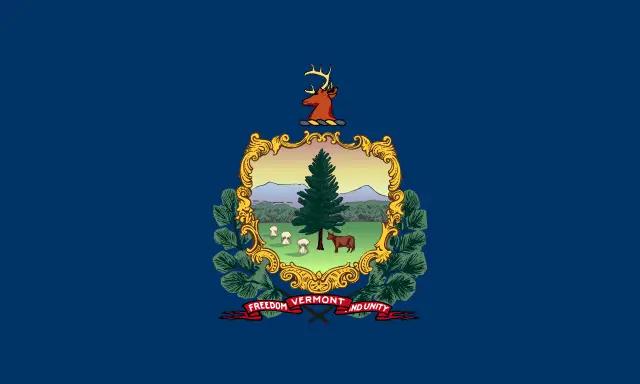State of Vermont
Nicknames: The Green Mountain State
Motto(s): “Freedom and Unity” and “Stella quarta decima fulgeat” (May the 14th star shine bright)
Date of Statehood: March 4, 1791 (14th state)
State Song: “These Green Mountains” by Diane Martin
Vermont Flag History
Vermont’s flag, adopted in 1923, consists of the state’s coat of arms on a field of azure. The coat of arms, designed in 1821, depicts a picturesque Vermont landscape. A pine tree stands at the center, flanked by sheaves of wheat and a cow, symbolizing the agricultural tradition of the state. The deer head atop the shield represents the state’s wildlife. The Green Mountains are in the background, with a sky composed of thirteen stars, representing Vermont as the 14th state to join the Union after the original thirteen.
The flag underwent its last significant change in 1923 when the current design was standardized. The flag’s rich symbolism serves as a tribute to Vermont’s natural beauty and its history of agriculture and hunting.
Vermont’s flag stands out for its detailed imagery and the deep meaning behind each element. It is a source of pride for Vermonters, representing the state’s past, present, and future.
Vermont Quick Facts
Capital City: Montpelier
Abbreviation: VT
Population: Approximately 623,000
Region: New England
Origin of State Name: Derived from “Montagne Verte,” French for Green Mountain
Sports Teams: No major professional sports teams, but various minor league teams
Bordering States: New York, New Hampshire, Massachusetts, and the Canadian province of Quebec
Area Codes: 802
Highest Point: Mount Mansfield at 4,395 feet (1,340 meters)
Lowest Point: Lake Champlain at 95 feet (29 meters)
Geography of Vermont
Area: 9,616 square miles (24,923 square kilometers), 45th largest
Land: 9,250 square miles (23,957 square kilometers), 43rd largest
Water: 366 square miles (947 square kilometers), 49th largest
Coastline: None (landlocked state)
Shoreline: Extensive along Lake Champlain and other lakes and rivers
Largest Cities:
- Burlington
- South Burlington
- Rutland
- Barre
- Montpelier
- Winooski
- St. Albans
- Newport
- Vergennes
- Essex
- Colchester
- Bennington
- Brattleboro
- Milton
- St. Johnsbury
National Parks:
- Marsh-Billings-Rockefeller National Historical Park
- Appalachian National Scenic Trail
Vermont State Symbols
Living Insignia
State Bird: Hermit Thrush
State Animal: Morgan Horse
State Amphibian: Northern Leopard Frog
State Butterfly: Monarch Butterfly
State Fish: Brook Trout
State Flower: Red Clover
State Horse Breed: Morgan Horse
State Insect: Honeybee
State Mammal: Morgan Horse
State Reptile: Painted Turtle
Inanimate Insignia
State Fruit: Apple
State Gemstone: Grossular Garnet
State Soil: Tunbridge Soil Series
State Tree: Sugar Maple
State Quarter: Released in 2001, featuring Camel’s Hump Mountain and Maple Trees
State Beverage: Milk
State Colors: Green and Gold
State Dance: Square Dance
State Food: Apple Pie
State Fossil: Beluga Whale (Delphinapterus leucas)
State Mineral: Talc
State Rock: Granite, Marble, and Slate

